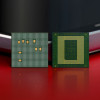Review: LG Voyager
You'd expect with the touch interface that the menu system would be vastly different from previous versions of the Verizon user interface. Well, it is definitely different, but you'll quickly learn that it is just a flashier version of the same old, same old.
First, there are two slightly different versions of the menu system. Starting with the exterior screen, there is a short-cut button to the main menu. Pressing it brings up a list of 8 applications: Get It Now, Messaging, Contacts, Recent Calls, Settings, Music, Browser, and Navigation. These menu items appear in a tall, two-column grid and cannot be changed or altered. Once you press any of them, the menu system reverts to the classic Verizon style, with a carousel of all the menu selections running across the top and your selection's choices listed below it. You can scroll sideways (with arrow buttons at the top of the screen) to get to other menu items without going back to the main screen, but of course you can do that, too.
Opening any of these items take you further into Verizon's submenus. They are the same as on most other Verizon phones, and can be tedious to wade through. There is a "clear" button on the screen that will always take you back one screen, and if there are any secondary actions to take, a corresponding button will appear next to the "clear" button. The hard clear button will also take you back on screen.
Strangely, if you just randomly tap the center of the Voyager's screen a full set of 12 different applications appears. Verizon calls this menu shortcuts. Why there are 8 items in the main menu and 12 items in the shortcut menu, we don't really understand. Rather than consisting of folders and subfolders, this shortcut menu is nothing but applications, such as the camera, music player or browser. Tapping any of the icons will open the application. When in these applications, hitting the "clear" button will take you back to the shortcut list. If you the "end" button, it will shoot you back out to the main screen.
When using the Voyager open, it is almost exactly like using an enV. The center of the D-pad opens the main menu, which is the same 8 applications/folders discussed above. The left function key opens the messaging center and the right function key opens your contacts. If you open the menu by tapping the D-pad, there is no difference in interacting with the main menu when compared to the main menu seen on the exterior screen. You are simply seeing a horizontal view of it, rather than vertical.










 Verizon Holiday Phones
Verizon Holiday Phones
 Hands On with the moto g power (2022)
Hands On with the moto g power (2022)
 Snapdragon 8 Gen 1 is Qualcomm's New Flagship Chip
Snapdragon 8 Gen 1 is Qualcomm's New Flagship Chip
 Hands On with the SoundCore Liberty 4 earbuds
Hands On with the SoundCore Liberty 4 earbuds
 Snapdragon 8 Gen 2 Redefines AI in Flagship Phones
Snapdragon 8 Gen 2 Redefines AI in Flagship Phones
 LG Voyager VX-10000
LG Voyager VX-10000

